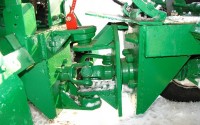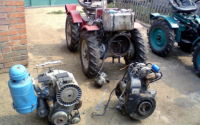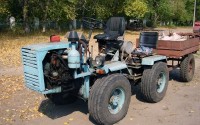The topic of manufacturing tractors for home yards is not new and has existed since the days of the USSR. Home-made tractors in those years were built by enthusiasts - loners to facilitate labor on the farm.
Tractor of the beginning of the century
And in our time, this occupation does not lose its relevance, despite the fact that industrial designs of minitractors have appeared on sale.
Someone is not satisfied with the price, someone does not like the technical data of such units, so people are engaged in the production of equipment “for themselves”. Many beginners are interested in choosing a circuit, engine, transmission of a home-made car. Let's try to understand them in more detail.
Choosing a homemade tractor frame scheme
The vast majority of samples of amateur tractor construction are wheeled vehicles, the only difference is in the frame layout, which can be a turning point or the same for the front and rear axles. Each scheme has its own advantages and disadvantages.
The breaking frame, as a rule, consists of two parts, which are connected by a hinge. The connection most often uses universal joints from the main gears of trucks, while the two ends of the cross are welded into the eye in order to limit the movements of the joint to only one degree of freedom (right - left).

Tractor frame design
The advantage of such a scheme can be called the increased maneuverability of the device, in contrast to the classical layout tractor with front steered wheels. An engine with a gearbox is placed on the front half-frame of such a machine, and the rear half-frame carries the rear axle and attachments.
The frame of the classical design is made according to the well-known principle. It is equipped with an engine with units, axles and attachments. The advantage of this design is ease of manufacture, although there are quite complex instances of the spatial scheme.
For the manufacture of frames of all schemes, mainly channels (6 - 10) and square pipes ranging in size from 40x40 to 80x80 millimeters are used. For the manufacture of less critical structural elements (wing frames, cladding), corners or rods of various sizes and diameters can be used.
Engines for homemade tractors
Most often, do-it-yourselfers use the engines at their disposal, while automobile engines (from cars) and power units from diesel and gasoline power plants (UD-2, UD-4) are the most popular. Boxer motorcycle engines are also quite common. Exotic (I hope so far) are samples of foreign engine building, for example, Japanese-made compact diesel engines. The main requirements for the engine are reliability and unpretentiousness in operation.

You can get by with UD engines
The engine should be selected based on its power and torque, as well as operating speed. Since a home-made tractor is designed primarily to perform any work on a personal plot or on a farm, it is not required to achieve high speeds. On the contrary, homemade mini tractors need the ability of the engine to develop high torque at low speeds, in this sense, of course, four-stroke diesel engines have an advantage.
Engines from ZAZ air-cooled cars have proven themselves well. In combination with well-chosen transmission units (gearbox and rear axle), these motors are able to work reliably and for a long time on home-made equipment, the same can be said about the engines of the “UD” family.
Transmission units
Very rarely, craftsmen complete engines with standard gearboxes. This is due to the fact that often the native box is not able to provide the required force on the drive wheels, so you have to look for ways out of such difficulties. One option is to connect a relatively low-power engine, such as the M-72, and a box from a GAZ-51 (53).

For such combinations, it is necessary to make a new clutch cover or adapter with holes for the studs, which ensures the alignment of the engine crankshaft and the gearbox input shaft. The adapter can be made of steel or aluminum alloys.
When making a homemade tractor with their own hands, craftsmen often supply it with a power take-off, an extremely necessary thing if it is necessary to work with hydraulic hitches. Power take-offs are also used from serial automotive or agricultural equipment, or they can be home-made (there is nothing fundamentally complicated there).
Bridges, like wheels, can be used in a variety of ways, from an elementary device from an Ant scooter to serious bridges from a truck. Alterations of the bridge, as a rule, come down to shortening the stockings and axle shafts (to give the required gauge dimensions), as well as the design of new seats for axle shaft bearings in stockings.
Project development
It is quite rare to find a do-it-yourselfer who makes a tractor according to pre-made drawings. Most do this: they place bridges with wheels on a flat surface, determine the installation location of the motor with the box, and begin to cut and weld the frame elements “in place”.

Homemade based on the T-16
Then, in the course of work, the necessary changes are made to the design. I can’t agree with this approach, it’s better to first make drawings and sketches, and then get to work, than to redo the structural elements later. If you have this approach to business, then homemade tractors with a breaking frame (and with an ordinary one) will leave the home assembly shop without the need for any modifications.